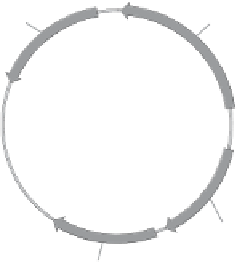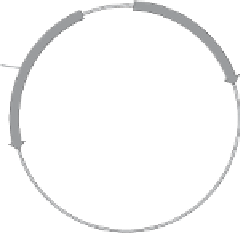Information Technology Reference
In-Depth Information
Optimizing
cI/
λ
P
(
R
-
O
12)
Inverters
Although the gain exhibited by the lacI/p(lac) is sufficient, other repressor/
promoter combinations can yield better signal restoration. One such example
is the
cI
/
λ
P(R
−
O
12
)
inverter. The
cI
repressor binds cooperatively to the
λ
pro-
λ
P(R
−
O
12
)
is
a synthetic promoter that we designed and that excludes
O
R
3 of the wild-type
λ
moter's
O
R
1 and
O
R
2 operators, which results in high gain. The
promoter. The affinity of
cI
to
O
R
3 is weak, and this operator would not
significantly enhance the repression efficiency of
cI
.
The
cI
monomer, also known as the
repressor, has an amino domain com-
posed of amino acids 1-92, a carboxyl domain of residues 132-236, and 40
remaining amino acids that connect the two domains [10]. The monomers as-
sociate to form dimers, which can then bind to the 17 basepair operator regions.
The intrinsic affinity of
cI
to
O
R
1 is about 10 times higher than to
O
R
2, and
therefore typically
cI
binds
O
R
1 first. However, the binding of
cI
to
O
R
1 imme-
diately increases the affinity of a second dimer to
O
R
2 because of the interaction
with the previously bound dimer. As a result, repressor dimers bind to
O
R
1 and
O
R
2 almost simultaneously. From a circuit engineering perspective, this coop-
erative binding leads to a much desired high gain because the transition from
low repression activity to high repression activity occurs over a small range of
repressor concentrations.
The genetic circuit to measure the device physics of the
cI
/
λ
λ
P(R
−
O
12
)
is
logically similar to the one used to measure the
lacI
/p(lac) inverter (Figure
7.8). Here, the
lacI
/p(lac) IMPLIES gate controls the level of the
cI
input. For
a particular experiment, the researcher sets the repressor level by controlling
the IPTG concentration.
Lambda P(R-O12)
RBSII
P3 P
EYFP
Kan(r)
lacI
AP
r
T0 Term
P(lacIq)
pINV-107
3759 bp
pINV-110
4887 bp
P(LAC)
p15A ori
RBSII
cI
T1 Term
ColE1 ORI
RBSII
ECFP
Figure 7.8
Genetic circuit to measure the transfer curve of
cI
/
λ
P(R
−
O
12
)
, using
lacI
as
driver.











